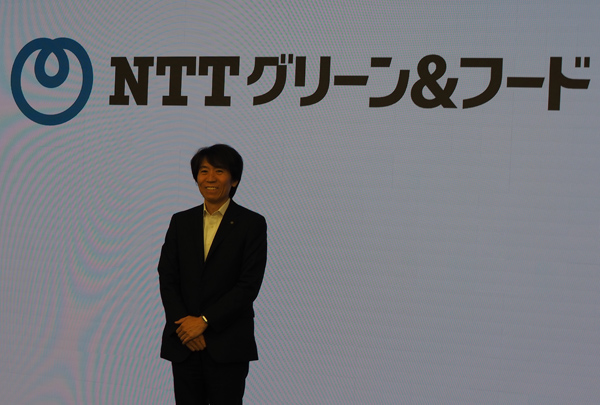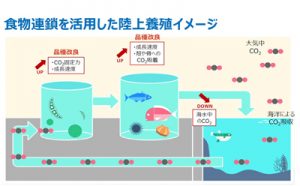Mission to solve food and environmental problems NTT Green & Food starts

NTT and Regional Fish have established a joint venture, NTT Green & Food Corporation.
NTT Green & Food’s mission is to take on the challenge of solving food and environmental problems, which are global concerns.
NTT’s Yoshikazu Kusumi, who became the president of NTT Green & Food, said, “Regional Fish possesses breeding technology for seafood and complete farming technology. NTT is researching algae that absorbs more CO2, We have cutting-edge technology such as selection technology, breed improvement technology, and AI and IoT.We want to combine these to tackle food and environmental problems.”
The green & food business can be advanced in two steps.
In Step 1, we will focus on the production and sale of environmentally friendly algae. Specifically, we will produce and sell algae that absorb more CO2 as feed for seafood. In the future, the company plans to expand sales to agricultural fertilizers and other products.
In addition, we have started to produce and sell eco-friendly seafood. Utilizing regional fish technology, we will develop the production and sales of fast-growing, high-value-added seafood.
In step 2, in addition to the production and sale of algae and seafood, we will package the mechanism for producing products, specifically the environmentally friendly land-based aquaculture system, and appeal to businesses and local governments.

For seafood, breeding techniques are applied to eliminate proteins that suppress the appetite of seafood and increase growth levels.
“Simply put, living things have an accelerator and a brake. This is how they maintain a state of equilibrium, but breeding removes the brake and promotes growth. In the case of tiger puffer, the growth rate is 1.9 times. I think it will be effective in solving the food problem,” said President Kusumi.
As the growth rate increases, so does the efficiency of feed utilization. Therefore, it will be possible to cover with about 40% of conventional feed.
Algae also have a kind of accelerator and brake, and releasing the brake activates the function of photosynthesis. As a result, the algae convert inorganic carbon such as CO2 into organic carbon compounds such as sugar, and increase the amount taken into the body.
This is called an increase in the amount of CO2 fixed, and increasing the amount of CO2 fixed in the ocean will result in a reduction in CO2 emissions.
The new company has a policy of treating land-based aquaculture as a single system and placing it at the core of its business.
First, seawater containing CO2 is taken in from the sea, and the algae promotes photosynthesis and grows large. Fish and shellfish eat the algae as food, fix CO2 in their flesh, bones, and shells, and return seawater with low CO2 concentration to the sea.
“I want to package these systems and deploy them in the region. By setting up plants and processing factories in the region, I would like to create jobs in the region and promote regional revitalization centered on land-based aquaculture,” says Kusumi. the president speaks.
First, we will start with several bases in Japan. We will produce and sell seafood suitable for the environment of each region as branded fish. The first base will be Kyushu, where it will produce and sell flounder.
We aim to achieve operating revenue of 10 billion yen by FY2028 and operating revenue of 30 billion yen by FY2033.
The current world population has exceeded 8 billion, and is predicted to exceed 10 billion in 30 years. In an era of population explosion, we can expect global competition for water, food, and resources. In particular, the demand for proteins, especially animal proteins, is expanding, and it is said that in 2030, a protein crisis will occur in which demand exceeds supply. If each country rushes to enclose food, it will become difficult for Japan to import food.
As for environmental issues, it is important to curb CO2 emissions, which are thought to be the cause of global warming. However, human activity does not emit CO2 from about 5% of the total. In fact, ocean CO2 emissions are seven times greater than human activity. On the other hand, the ocean also absorbs large amounts of CO2. It is absorbed by algae.
“Reducing CO2 emissions in the ocean and increasing CO2 absorption. This may be the key to solving global warming,” said Kusumi.
The new company will promote its business under these circumstances.
